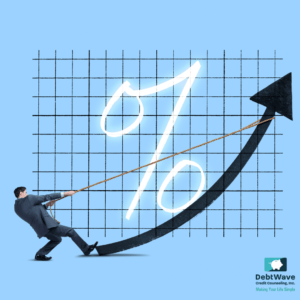Credit Card Utilization
Do you remember your first credit card?
For many of us, our first credit card was an exciting time in our lives. Many of us saw the limit on our credit cards as permission from the credit card company to spend up to that amount. Meaning if you had a $10,000 credit limit, most of us believed that meant you could spend $10,000 however and whenever you wanted to.
This is not only inaccurate, but it’s also a bad idea to spend more than you can afford to spend. Most financial professionals recommend you spend no more than 30 percent of your credit limit at any given time. This is to protect your credit utilization ratio.
What is an ideal utilization rate?
Credit card utilization — or just credit utilization, for short — refers to how much of your available credit you use at any given time. You can figure out your credit utilization ratio by dividing your total credit card balances by your total credit card limits. The resulting percentage is your credit card utilization ratio.
For example, if you have a total of $10,000 in credit available across three credit cards, and a balance of $5,000 on one of those cards, your credit utilization rate is 50 percent — you’re using half of the total credit you have available. You can calculate an overall credit utilization rate as well as a rate for each of your credit accounts (called your per-card ratio).
The goal is to aim for a credit utilization ratio of less than 30 percent, combined amongst all lines of credit, as well as per card or credit line. Once your credit utilization ratio reaches 30 percent or higher, you may start to hear increased warnings from your creditor about your spending.
That’s because too high of a balance on your credit card or maxing out your credit card can signal to your creditors that even you are not entirely sure how you’ll pay back what you owe, which can lead to many different kinds of consequences for you and your money.
The biggest consequence of all? You may have your credit limit reduced or revoked.
As outlined in the Fair Credit Reporting Act, credit card issuers have the right to lower credit limits at will and may do so when a cardholder appears to be in financial trouble.
This means if you miss a payment, carry over high debt, and/or only send in minimum payments, your credit card issuer may decide to reduce your credit line or even close the account.

How Much of My Credit Limit Can I Spend?
Keep in mind that your credit limit is based on your gross annual income as well as information from your credit report such as:
- Payment history
- Length of credit history
- The number of credit cards/credit lines on your account including mortgages, student loans, auto loans, personal loans, etc.
- Number of (recent) credit inquiries
- Number of derogatory marks on your account including bankruptcies, collections, civil judgments, or tax liens
Some issuers also check applicants’ credit reports to discover the limits that exist on their other credit cards. Other agencies compare different types of scores, such as the applicant’s credit score and bankruptcy score, to determine how much to fund the borrower.
There are other variables as well as the underwriting process varies from company to company and is protected by corporate trade secrets.
Regardless of the credit limit a creditor issues you, make sure you’re not biting off more than you can chew. If you end up spending more than you can afford to pay off initially, you may end up experiencing some unintended consequences for both you and your money.
Consequences of High Credit Utilization Ratio
1. Credit Score Impact
Technically a consumer can use up to 30 percent of your total credit limit before your credit score is negatively affected by your credit utilization ratio. Given that credit utilization comprises 30 percent of your credit score, your credit utilization ratio can have a dramatic impact on your credit score and the financial options available to you.
Essentially this means that if your score is on the verge of being in a lower credit score category, spending more than 30 percent of your credit limit may end with you paying higher interest and fees than you would if you hadn’t used as much of your available credit and remained in a higher credit score tier.
If you’re struggling to keep your credit balance at 30 percent or lower, consider scheduling a free budget analysis with one of DebtWave’s certified credit counselors. They’ll be able to give you personalized recommendations on how you can at least temporarily lower your expenses and/or increase your income to pay off your debt.
Remember, taking care of your debt when it’s a hill is a lot more digestible than when your debt turns into a mountain. Contact DebtWave as soon as you start to notice you’re having difficulty paying your credit card bills each month.
2. Financial Responsibility
Lenders like to see you can handle your credit responsibly. Having a revolving balance on a credit card account doesn’t necessarily mean you’re a high-risk borrower with a low credit score. But if you are consistently using a significant percentage of the credit available to you, it can imply to lenders that you are overextended and may be likely to miss payments in the future.
A good rule of thumb is to not utilize more than 30 to 40 percent of your credit limit at any given time. For example, if you have a $10,000 limit on your credit card, make sure to not have more than $3,000 to $4,000 worth of charges on the card at any given time.
This shows to the creditors that you are a responsible spender and are highly likely to pay back your debt in full.
3. Credit Card Limit Decreased and/or Revoked
Arguably the most painful consequence of having a high credit utilization ratio is if your creditor decided to lower your credit limit or revoke your credit limit altogether.
If this happens to you know that you are not alone. A bank or credit card issuer can generally lower (or increase) your credit limit at any time as long as it’s allowed in the credit card agreement.
One thing they can’t do is lower your credit limit and then immediately slap you with an over-the-limit fee or penalty fine if you happen to exceed the new lower credit limit. Your creditor must also give you at least 45 days from receiving notice of the lower limit to charge you any such fees.
If you have recently received notice from a creditor about a lower credit limit:
- Make sure nothing out of the ordinary has happened to your finances that might have caused the drop in your credit limit
- Check your credit reports for errors
- Focus on paying your bills on time
- Take steps to pay off your existing debts
You probably won’t see the results you want overnight, but you may qualify for a higher credit limit in the future.
For more personalized advice on how you can lower your credit utilization ratio or to speak with one of DebtWave’s certified credit counselors, schedule a complimentary budget analysis here.


[…] been given. While many believe that a credit limit of $10,000 means you can spend $10,000, that is unfortunately not accurate. Spending more than 30 percent of your credit limit often signals to your creditor that you are […]